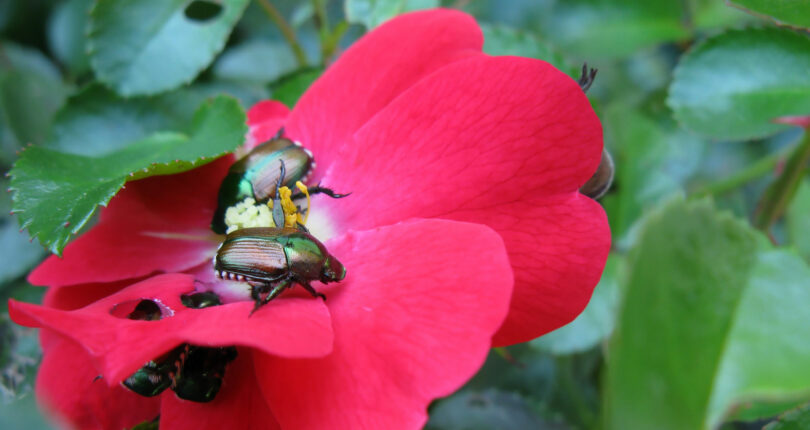One day you are admiring beautiful roses, only to find jagged petals and bare leaves the next day. How could this happen? Look closely to see if your roses are covered with the iridescent emerald of Japanese beetles. It’s a sight we all dread.
Is it possible to win the battle against Japanese beetles? The best strategy is to learn about their life cycle, most of which takes place underground in the larval stage. These C-shaped, white grubs begin to surface in early spring and feed on plant roots along the way. In late spring, they form pupae, which hatch a few weeks later into adult beetles. Adults rise to the surface, feast on foliage, and release pheromones to attract other beetles. After mating, females burrow 2–4 inches back into the soil, lay a few eggs, then return to the surface to eat and mate again. Eggs hatch after eight to 14 days, and grubs feed on plant roots again. During one season, females lay 40 to 60 eggs. This damaging cycle continues until autumn when temperatures drop and grubs burrow 6–18 inches into the soil where they remain inactive all winter.
Timing is essential for stopping this cycle. The most effective time to treat grubs is when they are near the soil surface. Consult with your extension office for recommendations. They may suggest biological controls such as soil-dwelling nematodes, like Heterorhabditis bacteriophora, which are commercially available. They may recommend mixing milky spore bacteria with water to spray on turf. They may suggest dusting with Sevin (which contains carbaryl) or treating with chemicals such as imidacloprid or halofenozide. There are various opinions as to the effectiveness of each approach.
If you miss the chance to control Japanese beetles in the grub stage, chances are your plants will become infested with adult beetles. Some people recommend applying pyrethrin spray or Neem oil to vegetables and flowers when the beetles first appear. Others have tried Japanese beetle traps, but traps contain pheromones and floral scents that could have the negative effect of attracting even more Japanese beetles.
Most gardeners who’ve experienced Japanese beetles are familiar with the daily ritual of picking or shaking them off plants early in the morning when they are less active. (Later in the day, the beetles fly away too quickly to catch). After capturing beetles in your hand, drown them in a jar of soapy water, closing the lid before they can escape.
After a summer of catching and destroying Japanese beetles, you may agree it would be easier to attack grubs in the soil. Or you may choose another option — avoid plants they like (e.g., roses, dahlias, zinnias) and grow flowers they dislike (e.g. coral bells, delphiniums, impatiens, and nasturtiums).
Master gardener Vicki Spencer has an eclectic background in conservation, water, natural resources, and more.

